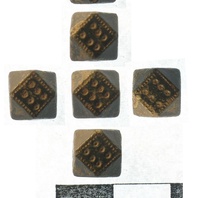
Viking Objects
Polyhedral Weight (SWYOR-3C5372)
This copper-alloy weight is of a type common within the Scandinavian diaspora. This example has fourteen sides and six dots on each of the rectangular sides. These weights were adopted by the Vikings from Middle Eastern examples and appear to have become a de facto weight standard for traders. Weights are an important form of evidence for Viking Age commerce and the use of standards across the different economic systems within which Vikings were integrated. Many of the weights discovered, particularly ones in Ireland and those of Arabic type, suggest that a standardized system of weights existed in some areas. These standard weights, alongside standard values of silver, are what allowed the bullion economy of Viking occupied areas to function. A bullion economy was a barter economy that relied on the exchange of set amounts of precious metal in various forms, such as arm-rings or coins, for tradable goods, such as food or textiles. Each merchant would have brought their own set of weights and scales to a transaction to make sure that the trade was conducted fairly.
Read More
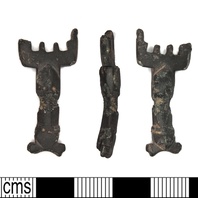
Viking Objects
Anglo-Scandinavian Key (LEIC-76C229)
Slide keys such as this example are generally known as ‘Viking keys’ due to similarities in shape with excavated examples. However, its T-shaped projections at the base have no identified parallels but the design could possibly show Anglo-Scandinavian influence. Keys were not only practical items but also symbols of status. Women often carried the keys to the family’s chests of valuables. They are also often buried with keys, representing their authority in the household. See also the blog post on keys in the Viking Age.
Read More
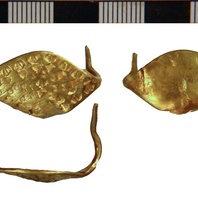
Viking Objects
Gold Finger-Ring (NLM-FC0D13)
A gold finger-ring featuring punched ring and dot decoration. The arms of this ring would have likely been twisted together which is a typically Scandinavian technique.
Read More

Viking Names
Snip
The Old Norse byname Snípr may be related to Modern Norwegian snipa ‘miser, unsociable person’. A single instance is recorded in Norway in 1335. It is also the first element of the place-name Snibstone, Leicestershire.
Read More
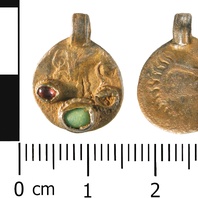
Viking Objects
Frankish Coin Pendant (WMID-24C235)
The coin that this pendant is made from was produced in North West France around 70-60 BC and is attributed to the Suessiones tribe. Later on the coin was adapted for use as a pendant and decorated with gilding and stone inlays. The colour and style of inlay give this pendant an early medieval dating and it is known that sometimes Iron Age coins were reused as pendants in Frankish jewellery. It is possible that it made its way to England prior to Viking incursions but it is equally likely that the Vikings brought this pendant with them as plunder after raiding in Frankia.
Read More
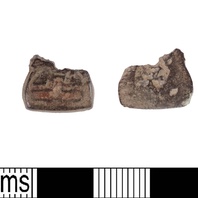
Viking Objects
Enamelled Irish Mount (LIN-9BCF25)
This item is a fragment of an Irish Early Medieval enamelled copper-alloy mount or strap-end. It is decorated with a rectangular perimeter of reserve metal which forms a ‘T’ shape. The recessed areas around and within it appear to contain degraded enamel. It is possible that it made its way to England prior to Viking incursions but it is equally likely, especially considering the Viking presence at Torksey, that the Vikings brought this mount with them as plunder after raiding various areas in Ireland.
Read More
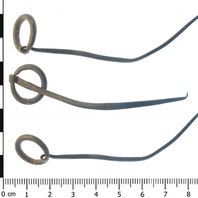
Viking Objects
Ring-Headed Pin (SWYOR-E57351)
The ringed pin was a form of dress fastener which developed as a result of contact between artisans in the Celtic West and sub-Roman Britain. The type became very popular in Ireland, being ultimately adopted by the Hiberno-Norse during the Viking period. In form it comprised a pin with a ring inserted through a looped, perforated or pierced head.
Read More
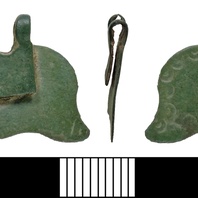
Viking Objects
Fish-Tail Pendant (DENO-08A172)
This copper-alloy pendant is in the shape of a symmetrical fish-tail decorated with a ring-and-dot motif around the edge. While the reverse of this object has traces of a silver coating, the front does not, which likely means that the silver coating represents solder used to keep the folded-over loops attached. For more information on Scandinavian jewellery in England check out our blog: Brooches, Pendants and Pins: Scandinavian Dress Accessories in England.
Read More
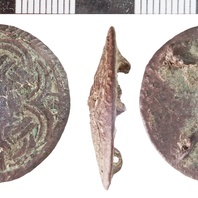
Viking Objects
Gilded Disc Brooch (NLM-783BCB)
This brooch is classed as Weetch Type 4 and resembles Viking-Age Terslev-style brooches. It is decorated with interlaced double strapwork and a cabled border and retains some traces of gilding. For more information on Scandinavian jewellery in England check out our blog: Brooches, Pendants and Pins: Scandinavian Dress Accessories in England.
Read More
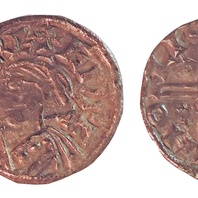
Viking Objects
Northumbrian Penny (NLM-0D491E)
This silver penny was minted in the name of King Eanred of Northumbria. The obverse shows a possibly helmeted and cuirassed individual and reads +EANRE AD RE; the initial cross doubles as X. The reverse reads +CO/ER/[?I]/HO/LI. This particular example was likely brought to Nottinghamshire from Northumbria by means of the Great Army’s overwintering activities in and around Nottingham.
Read More
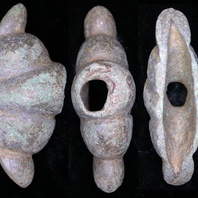
Viking Objects
Sword Pommel (LEIC-6D2448)
This copper-alloy sword pommel is made up of five lobes and is classed as a Petersen L type VI. Sword pommels were used to counter balance a sword as well as provide a decorative feature. In many cases they are the only method of identifying sword typologies.
